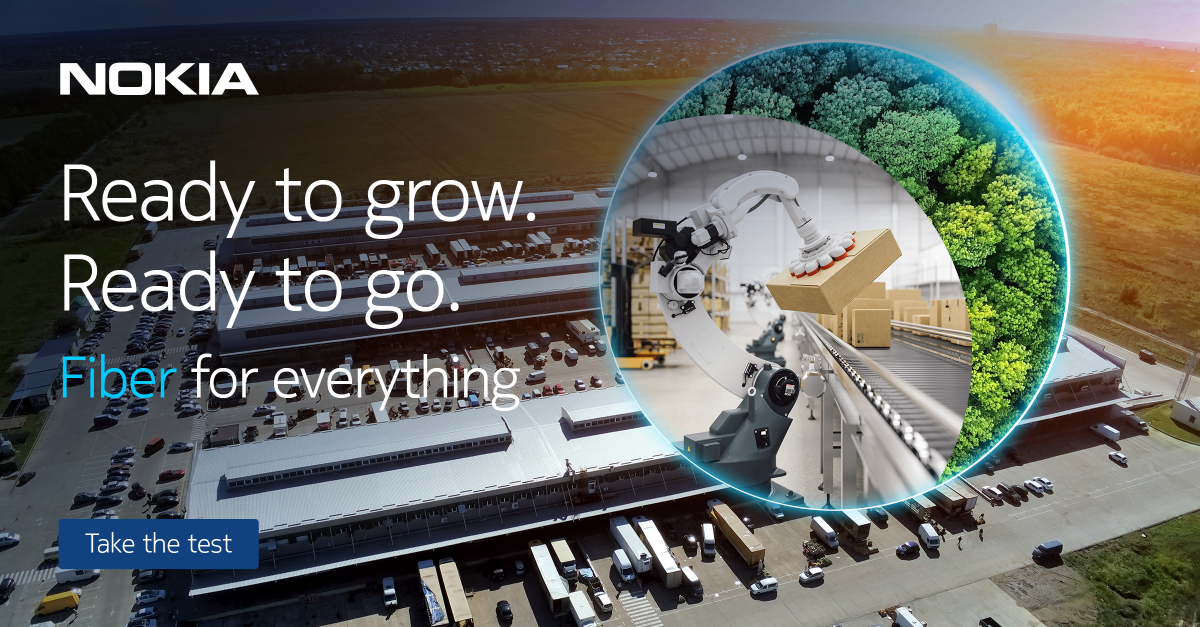Ana Pesovic, marketing director at Nokia discusses the shift that has taken place in the fibre market and how operators, end-users, society and our planet can benefit
There’s no denying that the attitude to fibre broadband has changed over the years. The use of light for communications dates back quite some time, with 1880 seeing Alexander Graham Bell and his assistant Charles Sumner Tainter create a very early model in the Photophone, which allowed for the transmission of sound on a beam of light. However, this would have to wait until advances in laser and optical fibre technologies caught up.
It was in the 1970s that optical fibre was developed with attenuation low enough for communications. This coincided with the development of GaAs semiconductor lasers that were compact and suitable for transmitting light through fibre optic cables at longer distances. But it was the mid-late 2000s in which fibre really began to come to the forefront commercially, as providers started to roll out fibre broadband networks. From then – the things were evolving at the speed of light.
A shift in attitude
The industry has put in a great deal of work in demonstrating the benefits of FTTH or full-fibre over other connections and the proof was certainly evident when it came to the move towards streaming, online gaming and, more recently, the need to participate in virtual meetings and attend virtual events. With the evolution to 5G and beyond for mobile, alongside the internet of things (IoT), smart factories and cities and other technological developments, the demand for the kind of signal strength, bandwidth and connection speeds that can only be achieved thanks to full-fibre will only increase, and providers understand that when they deploy their network, it needs to be fibre.
Governments in the majority of countries and markets also understand this, many of which have set ambitious targets for country-side full-fibre coverage. In the UK, for example, the government set a target of 85 per cent of premises covered by 2025, with nation-wide coverage by 2030. The US has a goal of 100 per cent broadband coverage which can achieve ‘minimally acceptable’ speeds, with ‘future-proof’ infrastructure such as fibre. Such governments have also put their money where their mouths are with investment and funding programmes to make sure that these targets will be met. Private investors are also seeing the benefits of putting money into fibre deployments and the figures show that this is making a difference.
In Europe, the total number of homes passed with FTTH/B in the EU39 countries (including the 27 EU countries, the UK and four CIS countries) reached nearly 198.4 million homes in September 2021, compared to 176.3 million in September 2020, according to the most recent Market Panorama report conducted on behalf of the FTTH Council Europe by iDate. Similarly, in the USA, the Fiber Broadband Association (FBA) found that the number of homes passed exceeds 60 million, up 12 per cent year-on-year from around 54 million in 2020, in a report compiled by RVA LLC Market Research and Consulting on FBA’s behalf.
It’s clear that fibre is now almost everywhere we turn. It passes every street, every corner, and every building. It is worth looking, therefore, at adopting it for more than just residential services. There would be no need to trench streets to add additional fibre for business services or mobile transport or smart city connectivity. It would be quick, easy, and cheap to connect new end points.
A shift in technology
Another big industry shift is the emergence of next-generation technology, such as PON. This has increased the available capacity. For example, in just the last 15 years we have become capable of delivering speeds 100 times faster than when fibre first became commercially deployed. With the commercial availability of 25G PON, and with 50G and 100G PON on the horizon, fibre PON unarguably now has enough bandwidth to support residential and business broadband, mobile backhaul, smart city and industry 4.0 traffic on a single infrastructure that is already deployed.
Latency has also been positively impacted. Residential broadband fibre is widely understood to be the king of low latency, but new applications like 5G fronthaul and many industry 4.0 applications require even lower latency that PON used to struggle to deliver. Today’s commercially available PON, however, uses innovative ranging processes, multiple bursts-per-frame per ONT, and the O-RAN defined cooperative transport interface to deliver sub-1ms latency.
A further consideration is programmability in the cloud. To run a single network with differing services, traffic types, customers, solutions, and generations of fibre technology, simple operations are required. Software defined networking (SDN) can provide that simplicity by moving some functionality from the network to the cloud, then running the algorithms and analytics in the cloud, resulting in automated operations. It also enables network slicing where a slice can be dedicated for each service on a converged fibre network. With slicing, a network can be shared more efficiently, because each slice can have its own quality of service and be operated independently.
A shift in benefits
The above developments have brought about a new paradigm. Rather than just FTTH; it is now fibre for everything (FFE) - a single infrastructure that underpins the entire industry. The benefits of this for operators include the ability to generate more revenues on networks by adding more use cases and services. This is pure margin, because there is very little additional investment required.
Operators are also allowed to introduce 5G small cells more efficiently, as leveraging the existing network is 50 per cent more cost efficient than a dedicated transport network. Power consumption can also be reduced because PON is a green technology, so the more customers added on a PON, the better for the carbon footprint. For example, moving business customers from a point-to-point to a converged PON network could provide 40 per cent power savings. Cable operators can benefit from 40 per cent lower cost of ownership by pre-aggregating remote DOCSIS nodes on a PON and extending service offerings to enterprises. Last but not least, operators can benefit from a single high-density network that is cheaper to deploy, maintain, and operate than multiple parallel networks.
It can be difficult to keep up with an ever changing industry, but while it is natural to be concerned about change, the shift that has taken place in the fibre industry in recent years is something about which we should all be excited. Fibre has never had more widespread appeal and we can all benefit from that fact, which is something worth celebrating.


